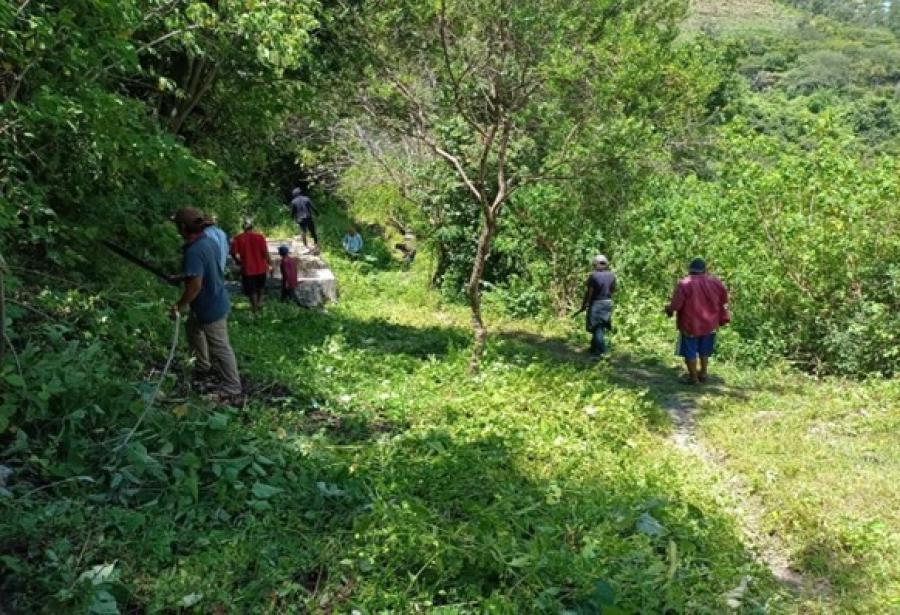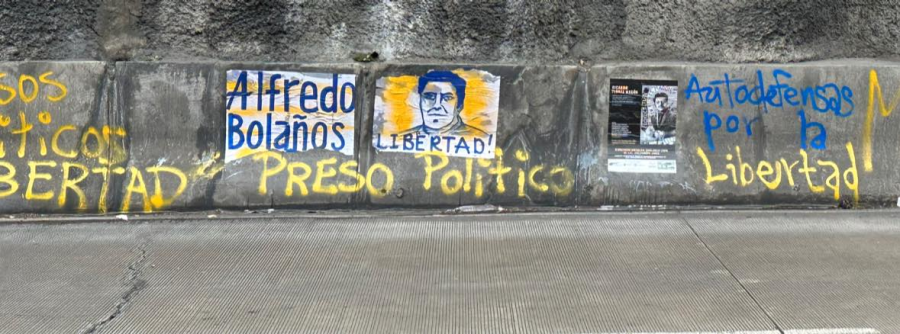Over half of the 13,000 square kilometer Lacandón Forest has been destroyed in the past 15 years by spontaneous and planned agricultural colonization, lumbering and cattle raising. If present trends continue, in as little as ten years the entire area will be deforested.
Mexico's last significant tropical forest, the Selva Lacandona, located in southeastern Chiapas, is a unique and extraordinarily rich wildlife habitat. It is one of the few remaining homes of endangered species such as jaguars, pumas, ocelots, spider and howling monkeys, crocodiles, giant tapirs and anteaters, harpy eagles, and numerous species of other birds. In modern times the area has been inhabited by the Lacandón Indians, some of whom still practice a highly efficient, ecologically sound system of tropical agro-forestry, related to ancient May agricultural techniques only now being rediscovered.
Classical Maya civilization probably supported more people in the Lacandón Forest, in an ecologically sounder way, than present use patterns. Recent radar remote sensing research has detected the traces of large, ancient, artificially modified and cultivated areas all over the Classic Maya lowland area, of which the Lacandón Forest is a part. It is thought that the Lacandón Indians, who remained relatively isolated until well into the twentieth century, preserved some of the ecological and agricultural skills of their Maya ancestors.
Traditional Lacandón agroforestry is a multiple land use system, involving the utilization of four different ecological zones: milpa (cleared forest plot); acahual (fallowed milpa); untouched forest; and aquatic-terrestrial ecotones (swamps, lakes, riverbanks, streams).
The milpa is cultivated for two to five years. In contrast to the maize monocultures of settlers unaccustomed to the selva, the Lacandones cultivate scores of different plants in their milpa plots. Individual plants are interspersed with different species, imitating the natural diversity of the forest and reducing losses from species specific pests and blights. As many as 79 different plant species are cultivated on a single hectare of Lancandón milpa.
The acahual is a source of both wild and deliberately seeded plant species. It is richer in utilized wildlife than the milpa or the forest, and is the Lacandones' primary source of animal protein. After a few years, the acahual is recleared and planted as a milpa. This reuses the same lands, rather than continually opening new areas of the forest.
The tropical forest itself contains about 100 species of edible plants which are consumed by the Lacandones. Aquatic areas provide significant protein in the form of fish, snails, frogs, turtles and crabs.
Since their relocation into three concentrated settlement areas by the Mexican government in the 1970s, less than one fifth of the 380 remaining Lacandones continue to practice their traditional agroforestry.
While the Mexican government was accelerating the deculturation of the Lacandones, Mexican scientific institutions were showing increasing interest in traditional indigenous systems of tropical forest management in Chiapas. The Centre de Ecodesarrollo, in Mexico City, studied Lacandón agroforestry. Th Nacional de Investigaciones Sobre Recursos Bioticos (INIREB) set up experimental agricultural plots in the Lacondón Forest which utilize pre-Columbian agricultural techniques such as chinampas (raised fields in swampy areas) to obtain higher yields than methods prevalent among present settlers. In fact, a number of the campesinos adjacent to the INIREB plots have adopted some of the very techniques thought to have been used by their ancestors - a situation which one Mexican government report proudly cites as an example of successful "technology transfer"!
A closer look at the history of the Lacandón Forest reveals a paradigm of the deforestation process in Latin America, and indeed, in many tropical areas of the rest of the world.
At the time of the Spanish Conquest the inhabitants of the region, Chol, Choltis and Tzeltal speaking Indians, were forced to live in villages outside the jungle so they could be more easily controlled. The Lacandones then emigrated from what is now Guatemala to the Lacandón Forest.
The Mexican Revolution did not come to Chiapas until the 1940s, when land reform laws finally were partially implemented. As a result, tens of thousands of Indians all over Chiapas - many of them Tzeltales and Chols - were freed from debt peonage and encouraged by the government to settle in the forest. Unaccustomed to the Lacandón area and its acidic, relatively infertile soils, they used systems of slash and burn agriculture which concentrated on raising a limited number of cash and subsistence crops and which quickly exhausted the soil, leaving it fit only for cattle pastures. Increasing numbers of landless Indians descended from the Chiapas highlands - a region itself suffering from severe deforestation, erosion, and declining soil fertility. The indigenous settlers became the unwitting shock troops of deforestation, clearing the forest lands acquired by ladino (non-Indian) cattle ranchers, to be chased off after a few harvests by the cattlemen. In other instances, the Indians obtained title to ejidos (communial landholdings with individual rights of usufruct), but illegally rented the exhausted ejido lands to cattle ranchers. In the mid 1970s, ranchers were paid ten pesos, or about 80 cents, per month, per animal for grazing rights, each animal needing just over one acre of pasture.
Through the 1960s and 1970s lumbering increased deforestation, as much through the construction of penetration roads, which allowed spontaneous settlement, as through the actual cutting of the forest. Ironically, agricultural and ranching activity increased pressure to accelerate the pace of lumbering, because Mexican government officials were concerned that the clearing by campesinos was destroying valuable tropical hardwoods.
In March 1972, the Mexican government issued a decree which established 6,143 square kilometers of the Lacandón Forest as the sole property and home of the Lacandón Indians. This action was not motivated by altruism. Recent Indian settlers of Chol and Tzeltal origin were resettled in colonization centers, and the Lacandones were resettled in three centralized villages, where they experienced epidemics of influenza and intestinal diseases. After a short interlude, large-scale exploitation of cedar, mahogany and ceiba was undertaken by La Compania Forestal de Lacandona, purchased from the Chiapas governor's family by Nacional Financiera, S.A. (NAFINSA), the Mexican national industrial development corporation. This lumbering activity was initiated through concession contracts, which the Lacandones were induced to sign. NAFINSA distributed 30% of the Lacandones' financial share directly to them, and the other 70% was put in a trust fund. According to James Nations, most Lacandones did not understand what was happening, and referred to the officials who paid them for the destruction of their forest as "the men who make gifts of money." In effect, given the Lacandones title to their land created a more efficient institutional framework for destroying it.
Increasingly, other government institutions such as INIREB, the Centre de Ecodesarrollo, and the Institute Nacional de Ecologia were concerned about uncontrolled and destructive development in Chiapas and, under the previous presidential regime of Luis Echeverria, prepared studies on the Lacandón area. These studies were undertaken with the purpose of promoting ecologically more balanced development for the region. Unfortunately, under the administration of Lopez Portillo none of these plans was followed up.
In 1977, the government set aside 3,312 square kilometers of the Lacandón Forest as a Biosphere Reserve under 'Project 8' of the UNESCO Man and the Biosphere Program (MAB). The purpose of the UNESCO MAB Project 8 is to set aside protected areas of representative ecosystems throughout the world. Biosphere reserves, as opposed to other protected areas such as national parks, are chosen for their genetic significance, and not on the basis of other considerations such as scenic beauty.
Regrettably, the Lacandón Biosphere Reserve "Montes Azules" is so far only a legal fiction, since the area is increasingly invaded by Mexican slash and burn cultivators, Guatemalan refugees, cattle ranchers and illegal poachers. Even PEMEX, Mexico's national petroleum company, is undertaking oil development activities within the Montes Azules area, where large oil reserves are thought to lie.
In spite of this melancholy but paradigmatic story of deforestation, up to 6,000 square kilometers of untouched forest may still remain. This means that what is left of the Lacondón Forest still is probably three times larger than any other tropical forest in Mexico.
This year Mexico changes presidents, and the next president might well be the last able to promote conservation and rational management of the Lacondón region. By this time next year, most priorities and plans of the incoming Miguel de la Madrid administration will be fixed. Mexico has the scientific and economic expertise to implement a multiple land-use program of ecologically sound development for an area like the Lacondón Forest. Such a regional plan could include traditional Lacondón agroforestry by protecting natural areas while at the same time allowing diverse forms of forest agriculture.
Recently, some international institutions have shown interest in Chiapas. The World Bank has been approached by NAFINSA for agricultural development loans. In June, the World Wildlife Fund, in cooperation with the Natural Resources Defense Council, is sending a team to Chiapas to explore conservation possibilities for the Lacandón area. These international organizations could act as catalysts to bring together already existing Mexican research, environmentally balanced development and conservation of the Lacandón region.
There are thousands of square kilometers of pristine forest remaining, so it is still not too late - but time is rapidly running out for the Lacandón Forest.
Article copyright Cultural Survival, Inc.



